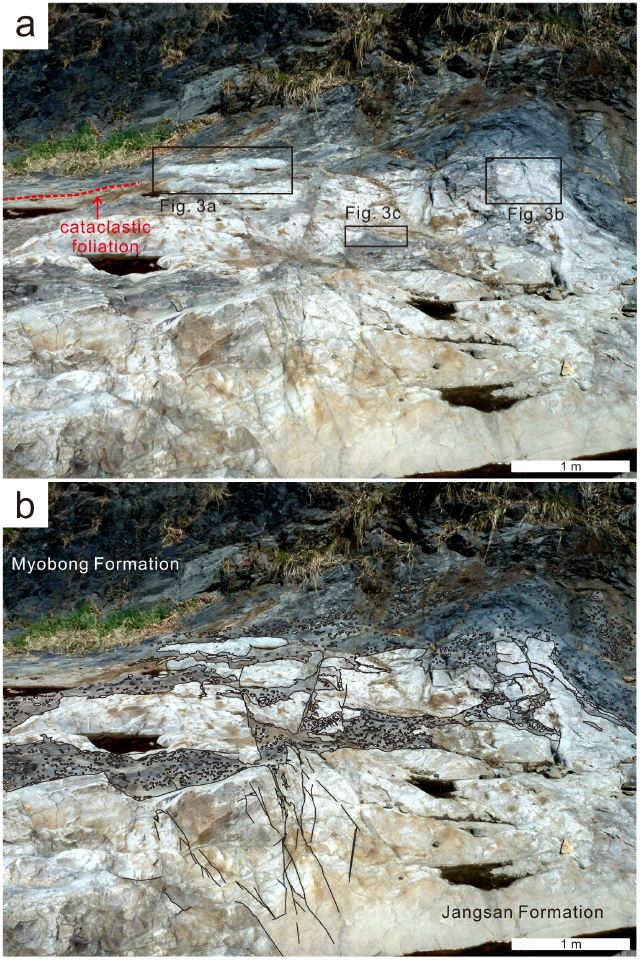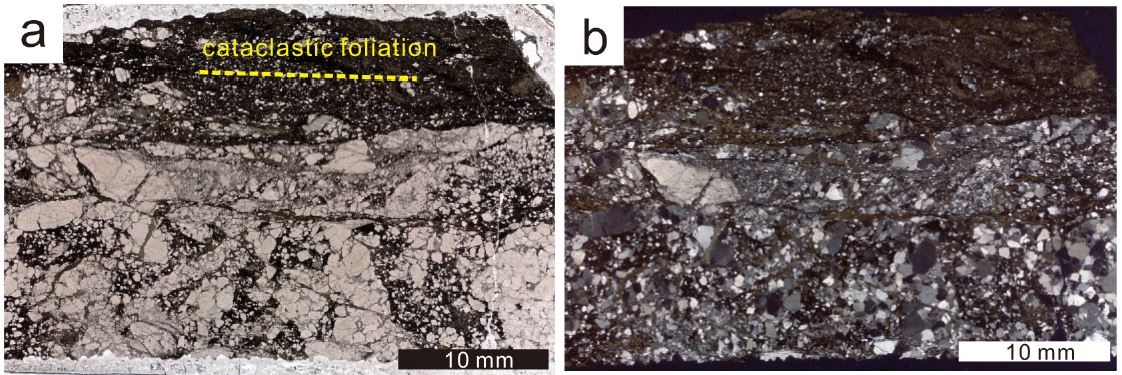
“태백산분지에 분포하는 장산층의 퇴적시기 및 암석 특성 재고찰”에 대한 반론
초록
이용일 외(2016a, 지질학회지 52, 67-77)의 논평은 장산층(규암)과 묘봉층(셰일)이 부정합으로 접하고 있다는 관찰과 해석에 기반하고 있다. 부정합의 중요한 증거로 제시된 동점역 인근 낙동강 하상의 노두를 재관찰한 결과, 두 층의 불규칙한 경계는 퇴적 당시 하부층을 침식한 1차 퇴적구조가 아닌, 퇴적후 지하 심부에서 발생한 변형작용(단층)에 기인한 2차 구조로 해석된다. 두 층이 접하는 불규칙한 경계는 위에 놓인 묘봉층의 주향 경사와 평행하지 않다. 이 불규칙한 경계를 따라 단층파쇄암과 단층비지가 존재하며, 또한 단층비지가 단열면을 따라 장산층의 규암내로 일부 주입되어 있다. 이와 같은 단층비지의 주입현상은 단층대에 국한되어있다. 장산층과 묘봉층이 접하는 불규칙한 경계에는 오랜 기간 동안 퇴적작용이 중단되었거나 지질학적으로 긴 시간적 간격이 있었음을 지시하는 어떠한 증거도 없다. 그러므로 장산층과 묘봉층 사이의 부정합 관계를 바탕으로 한 층서, 퇴적 시기, 퇴적물 공급지 및 고지리에 대한 해석과 가설은 그 근거가 없다.
Abstract
An underpinning theme of Lee et al. (2016a, Journal of the Geological Society of Korea, 52, 67-77) is based on an invalid observation/interpretation of “unconformity” between the Jangsan Formation (quartzite) and the overlying Myobong Formation (shale). Re-examination of the Dongjeom outcrop section along the floor of the Nakdong River indicates that the irregular boundary between the two formations is not representative of a depositional (primary) sedimentary structure, but a post-depositional (secondary) deformation structure caused by subsurface faulting. The irregular fault contact is not parallel with bedding of the overlying Myobong Formation. Cataclasite and fault gouge are present along the irregular boundary, and fault gouge is injected into the fractures of the quartzite. Such injection occurs only in the fault zone. There is no evidence of a substantial break of sedimentation or gap in the geologic record across the irregular boundary between the two formations. Their further assertion on the stratigraphy, depositional age, provenance, and the paleogeography of the two formations is thus rootless.
Keywords:
Taebaeksan Basin, Jangsan Formation, Myobong Formation, post-depositional deformation, cataclasite, fault gouge키워드:
태백산분지, 장산층, 묘봉층, 퇴적후 변형구조, 단층 파쇄암, 단층비지1. 서 론
이용일 외(2016a)는 최근 지질학회지 논평 “태백산분지에 분포하는 장산층의 퇴적시기 및 암석 특성 재고찰”에서 장산층과 묘봉층이 부정합적 관계로 접한다는 주장을 바탕으로 장산층의 퇴적시기에 대해 논의하였다. 두 층 사이의 부정합적 관계를 보여준다는 노두 관찰의 내용은 저자들이 발표한 일련의 논문들(Kim and Lee, 2006; Lee et al., 2012)에서 인용하고 있다. Kim and Lee (2006)은 태백 연화 제1광산과[Kim and Lee (2006)에는 연화 제2광산으로 기재되어 있으나 위치상 연화 제1광산으로 판단됨] 동점, 그리고 정선 덕암 지역에서 장산층과 묘봉층 사이 경계부를 부정합으로 처음 해석하였으며(Kim and Lee, 2006, p. 394, 그림 4), 이 중 동점지역 노두의 규암과 셰일 접촉부가 보이는 불규칙한 경계면과 셰일에 포함된 규암 “역”을 부정합의 증거로 재차 제시하였다(Lee et al., 2012, p. 265, 그림 5). 이와 같은 태백층군의 층서관계에 대한 의견은 Lee et al. (2016b)에 개략적인 주상도(Lee et al., 2016b, p. 773, 그림 3)의 형태로 표현되어 있다. 최근 우리는 두 층 사이에 “부정합”이 존재한다는 근거의 중심이 된 동점지역 노두에 대한 재조사를 실시하였다.
2. 동점지역 노두에 대한 새로운 관찰결과
동점역에서 남동쪽으로 약 500 m 떨어진 낙동강 하상에 위치한 이 노두(그림 1a)에서 석영사암(규암)으로 구성된 장산층과 셰일(슬레이트)로 구성된 묘봉층이 N20E주향에 80°의 북서경사를 갖는 단층을 경계로 접하고 있으며, 이 단층과 묘봉층 사이에는 안산암질 암맥(두께 4-5 m)이 관입되어 있다(그림 1c). 이 단층의 단층면에 있는 거의 수평한 단층조선과 지질도 상에서 보이는 단층에 의한 층의 오프셋은(그림 1a) 이 단층이 좌수주향이동단층임을 지시한다. 장산층과 묘봉층의 층리면은 북동방향의 주향에 북서쪽으로 경사한다(그림 1b, 1c). 이 노두의 북서쪽 하상을 관찰하면 하부의 석영사암(장산층)과 상부의 셰일(묘봉층)이 동-서 주향에 북쪽으로 경사하는 경계를 따라 접하며(그림 1b, 1c), 이 불규칙한 경계와 그 위 묘봉층의 층리는 서로 평행하지 않다. 이 불규칙한 경계가 “부정합”이 될 수 없는 증거는 다음과 같다.
- 1) 하부의 규암과 상부 셰일과의 경계는 불규칙한 수지상의 터널형태를 이루며 하부로 연결되어 있다(그림 2, 3). 수지상으로 뻗은 불규칙한 통로는 규암과 셰일의 각력편을 다량 포함한 세립질 물질로 채워져 있으며 횡적 연속성이 결여되어 있다(그림 2, 3a, 3b, 3c). 두 층 사이의 이러한 불규칙한 경계면과 세립질 물질에 포함된 규암 역들(Lee et al., 2012, p. 265, 그림 5)은 상부 층이 퇴적되기 전 하부 층(규암)이 침식된 후 셰일이 채운 퇴적구조(scour and fill)가 아니며, 깨진 규암의 균열을 따라 주입된 단층 기원의 변형구조이다. 이 경계부에서 묘봉층의 셰일 또한 일부 잘리고 파쇄되어 각력을 이루며(그림 3d), 이는 셰일 역시 변형 당시 고화상태에 있었음을 의미한다.
- 2) 이 불규칙한 경계를 따라 하부의 장산층 규암과 상부의 묘봉층 셰일 모두 심하게 파쇄되어 있으며, 규암과 실트암의 접촉부를 따라 파쇄엽리(cataclastic foliation)가 잘 발달되어 있다(그림 2, 3). 파쇄엽리는 판상규산염광물과 렌즈상 파쇄물집합체의 선택적 배열로 정의된다(그림 2, 3, 4). 특히 이 불규칙한 경계대 내에 상부의 셰일이 파쇄되어 각력 상태로 혼입되어 존재하는 사실은(그림 3d) 이 경계부가 부정합이 아니라 단층대임을 의미한다.
- 3) 두 층이 접하는 불규칙한 경계부 주변의 암석은 규암층의 석영이 심하게 파쇄된 단층파쇄암(cataclasite)과 백운모, 녹니석, 점토광물을 포함하는 판상규산염광물로 구성된 단층비지(fault gouge)로 이루어져 있다(그림 4). 단층비지를 따라 티탄철석과 자류철석이 파쇄엽리와 평행한 방향으로 배열을 하며 성장한 사실은 단층 운동 당시 유체의 유동이 있었음을 지시한다.
- 4) 불규칙한 경계 하부의 규암에 수지상으로 발달한 단열면(fracture)을 따라 단층비지가 주입(그림 3b)된 것은 단층 운동 시 발생한 높은 유체압의 효과로 단층암이 유동화(fluidized)되었다는 것을 지시한다(Smith et al., 2008; Kirkpatrick and Shipton, 2009; Rowe et al., 2012; Fagereng et al., 2014).
즉 셰일에 포함된 규암역들은(그림 2b, 3a, 3c) 하부 규암층이 침식되어 생성된 것이 아니라, 단층에 의해 형성된 단층암의 각력편이며, 각력편은 세립질의 단층비지가 둘러싸고 있다. 이러한 현상은 동점역 인근 조사 지역의 단층대 주변에만 국지적으로 나타날 뿐, 태백층군 분포지 중 다른 장산층과 묘봉층의 경계부에는 관찰되지 않는다는 사실 또한 두 층의 층서적 관계가 “부정합”이 될 수 없음을 시사한다.

Geologic map (a), outcrop photograph (b) and line drawing (c) of Dongjeom section (modified after Chough, 2013). Man in the ellipsoid in Figure 1b for scale. Solid lines: faults. Dotted lines: bedding plane of the Jangsan and Myobong formations. PCB=Precambrian basement, Js=Jangsan Formation, Ms=Myeonsan Formation, Mb=Myobong Formation, Dg=Daegi Formation.

Photograph (a) and line drawing (contrast shading) (b) of the fault zone between the shale (Myobong Formation) and the underlying quartzite body (Jangsan Formation). For location, see Figure 1.

Close-up photographs of the fault zone. For location, see Figure 2. (a) Quartzite fragments detached from main quartzite body of the Jangsan Formation. Note the angular jigsaw-fit boundary associated with faulting. (b) Downward injection of fault gouge into the quartzite body with lateral offshoots, forming a network of gouge cracks. (c) Brecciated fragments of quartzite mixed with gouge material. (d) Angular fragments of shale (Myobong Formation) within the fault zone.
3. 결 론
결론적으로, 위에 열거한 증거들은 저자들이 주장해온 장산층과 묘봉층의 “부정합” 관계를 부정한다. 동점역 인근 노두의 장산층과 묘봉층의 경계에는 퇴적작용이 중단되었거나, 지질학적으로 긴 시간적 간격(a substantial break or gap in the geologic record)이 존재하였다는 어떠한 증거도 없다. 즉, 장산층과 묘봉층의 정합적관계(GICTR, 1962; Kobayashi, 1966; Chough et al., 2000; Choi and Chough, 2005; Kwon et al., 2006; Woo et al., 2006; Chough, 2013)를 부정하는 것은 논리적이지 않으며, 태백층군 하부의 층서와 퇴적시기에 관하여 제안한 일련의 가설들(e.g., Lee et al., 2012, 2016b)은 그 근거가 없으므로 유효하지 않다. 특히 지질연대, 퇴적물 공급지 및 고지리에 관한 연구결과의 문제점은 Cho and Cheong (2016)과 Kim and Ree (2016)에서 상세히 지적되었다.
Acknowledgments
논문에 대해 다양한 의견을 제시해주고 현장조사를 도와준 이현석 박사와 이정현 교수, 그리고 김재훈 학생께 감사드린다. 본 원고를 읽고 유익한 조언을 준 유인창 교수와 익명의 심사자께 감사한다. 이 연구는 한국연구재단 중견연구자지원사업(2015R1A2A2A01007063)의 일환으로 이루어졌다.
References
-
Cho, M., and Cheong, W., (2016), Comments on “Detrital zircon geochronology and Nd isotope geochemistry of the basal succession of the Taebaeksan Basin, South Korea: Implications for the Gondwana linkage of the Sino-Korean (North China) Block during the Neoproterozoic-early Cambrian” by Lee et al. [Palaeogeography, Palaeoclimatology, Palaeoecology, 441(2016), 770-786], Palaeogeography, Palaeoclimatology, Palaeoecology, 459, p606-609.
[https://doi.org/10.1016/j.palaeo.2016.04.024]

-
Choi, D.K., and Chough, S.K., (2005), The Cambrian-Ordovician stratigraphy of the Taebaeksan Basin, Korea: a review, Geosciences Journal, 9, p187-214.
[https://doi.org/10.1007/BF02910579]

- Chough, S.K., (2013), Geology and Sedimentology of the Korean Peninsula, Elsevier, London, p363.
-
Chough, S.K., Kwon, S.T., Ree, J.H., and Choi, D.K., (2000), Tectonic and sedimentary evolution of the Korean peninsula: a review and new view, Earth-Science Reviews, 52, p175-235.
[https://doi.org/10.1016/S0012-8252(00)00029-5]

- Geological Investigation Corps of the Taebaeksan Region, (1962), Geological Atlas of Taebaeksan Region, Geological Society of Korea, p107, (in Korean).
-
Fagereng, R., Smith, Z., Rowe, C.D., Makhubu, B., and Sylvester, F.Y.G., (2014), Stress, strain, and fault behavior at a thrust ramp: Insights from the Naukluft thrust, Namibia, Journal of Structural Geology, 58, p95-107.
[https://doi.org/10.1016/j.jsg.2013.11.002]

-
Kim, H.S., and Ree, J.H., (2016), Comment on “detrital zircon geochronology and Nd isotope geochemistry of the basal succession of the Taebaeksan Basin, South Korea: Implications for the Gondwana linkage of the Sino-Korean (North China) block during the Neoproterozoic-early Cambrian” by Lee, Y.I., Choi, T., Lim, H.S. and Orihashi, Y. [Palaeogeography, Palaeoclimatology, Palaeoecology, 441(2016), 770-786], Palaeogeography, Palaeoclimatology, Palaeoecology, 459, p610-612.
[https://doi.org/10.1016/j.palaeo.2016.04.031]

-
Kim, Y.I., and Lee, Y.I., (2006), Early evolution of the Duwibong Unit of the lower Paleozoic Joseon Supergroup, Korea: A new view, Geosciences Journal, 10, p391-402.
[https://doi.org/10.1007/BF02910434]

-
Kirkpatrick, J.D., and Shipton, Z.K., (2009), Geologic evidence for multiple slip weakening mechanisms during seismic slip in crystalline rock, Journal of Geophysical Research, 114, pB12401.
[https://doi.org/10.1029/2008JB006037]

- Kobayashi, T., (1966), The Cambro.Ordovician formations and faunas of South Korea, Part X, Stratigraphy of the Chosen Group in Korea and South Manchuria and its relation to the Cambro-Ordovician formations of other areas, Section A, The Chosen Group of South Korea, Journal of the Faculty of Science, University of Tokyo, Section II, 16, p1-84.
-
Kwon, Y.K., Chough, S.K., Choi, D.K., and Lee, D.J., (2006), Sequence stratigraphy of the Taebaek Group (Cambrian-Ordovician), mideast Korea, Sedimentary Geology, 196, p19-55.
[https://doi.org/10.1016/j.sedgeo.2006.03.024]

-
Lee, Y.I., Choi, T., and Lim, H.S., (2016a), Depositional age and petrological characteristics of the Jangsan Formation in the Taebaeksan Basin, Korea-revisited, Journal of the Geological Society of Korea, 52, p67-77, (in Korean with English abstract).
[https://doi.org/10.14770/jgsk.2016.52.1.67]

-
Lee, Y.I., Choi, T., Lim, H.S., and Orihashi, Y., (2012), Detrital ziron U-Pb ages of the Jangsan Formation in the northeastern Okcheon Belt, Korea and its implications for material source, provenance, and tectonic setting, Sedimentary Geology, 282, p256-267.
[https://doi.org/10.1016/j.sedgeo.2012.09.005]

-
Lee, Y.I., Choi, T., Lim, H.S., and Orihashi, Y., (2016b), Detrital zircon chronology and Nd isotope geochemistry of the basal succession of the Taebaeksan Basin, South Korea: Implications for Gondwana linkage of the Sino-Korean (North China) block during the Neoproterozoic-early Cambrian, Palaeogeography, Palaeoclimatology, Palaeoecoloy, 441, p770-786.
[https://doi.org/10.1016/j.palaeo.2015.10.025]

-
Rowe, C.D., Kirkpatrick, J.D., and Brodsky, E.E., (2012), Fault rock injections record paleoearthquakes, Earth and Planetary Science Letters, 335-336, 154-166.
[https://doi.org/10.1016/j.epsl.2012.04.015]

-
Smith, S.A.F., Collettini, C., and Holdsworth, R.E., (2008), Recognizing the seismic cycle in ancient faults: CO2- induced fluidization of breccias in the footwall of a sealing low-angle normal fault, Journal of Structural Geology, 30, p1034-1046.
[https://doi.org/10.1016/j.jsg.2008.04.010]

-
Woo, J., Shinn, Y.J., Kwon, Y.K., and Chough, S.K., (2006), The Jangsan and Myeonsan formations (Early Cambrian) of the Taebaek Group, Mideast Korea: Depositional processes and environments, Geosciences Journal, 10, p35-57.
[https://doi.org/10.1007/BF02910331]


